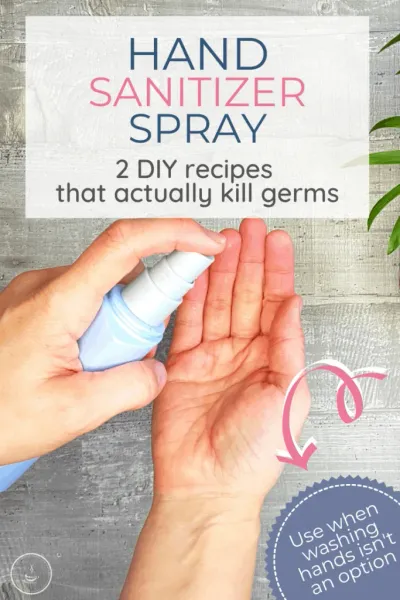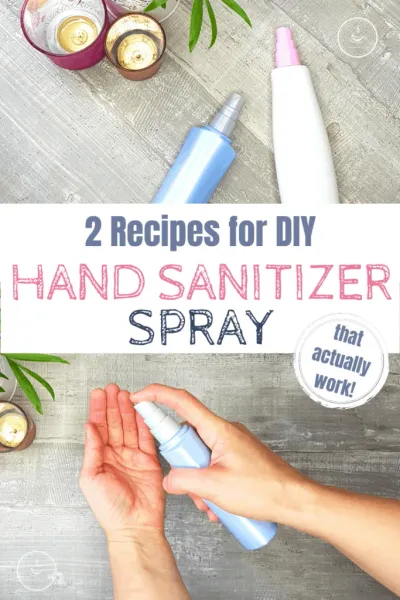Would you like to make your own hand sanitizer? In this post, I'll show you two recipes that actually work. Plus, I'll share their pros and cons so you easily find the disinfectant spray that works best for you. And finally, there's a video included, demonstrating the correct application of hand sanitizers so you really kill those nasty germs.

Washing your hands is and will remain one of the most effective ways to prevent diseases that humankind ever discovered. And you don't even need to use antibacterial soap. I'm sure you heard by now that being killing too many germs has more disadvantages than positive effects. That is, if you are generally healthy and not trying to ward off a nasty virus.
How to make your own hand sanitizer
Even in all the hype about a new flu-like virus, washing your hands is still your best bet. But there are situations where it's simply not an option:
- while shopping
- when using public transportation
- or on travels
Yet even if you have to resort to a hand sanitizer, it doesn't have to be the store-bought kind. Only a few ingredients are necessary to make your own homemade hand sanitizer - and one that actually works.
This is especially helpful when a media-amplified panic about a new virus leads to empty shelves in the hand sanitizer aisle.
Do homemade hand sanitizers work at all?
There is no shortage of recipes for homemade alternatives to store-bought products on the Internet. But as the CDC states, DIY hand sanitizers must contain at least 60% alcohol in the final product in order to be effective.
It's the only way to actually kill most pathogens rather than just inhibiting their growth. Unfortunately, this means that a majority of natural DIY solutions are only partially effective.
Many popular natural recipes simply contain too little alcohol: either because they are using low-proof alcohol products (such as vodka) or because they recommend diluting it too much (e.g. with aloe vera).
It is still important to keep in mind, though, that even store-bought hand sanitizers do not work as well as thorough handwashing: with soap, warm water, and for about 20 seconds. So whenever that's an option, it should be your preferred way to clean your hands - and prevent diseases.
Pro's and con's of DIY disinfectant spray
The biggest downside is that the ingredients of both recipes listed below aren't exactly standard household supplies. That means they are certainly not cheaper than a ready-made product.
However, you have full control over the ingredients, which I consider a big plus even though I don't live in fear of chemicals. Many ingredients at least appear to be much more natural than the unpronounceable contents of store-bought products.

Ingredients of homemade hand sanitizers
To better understand how the disinfectants work, I'll briefly explain why the ingredients work. Note: Not every ingredient listed below is being used in each recipe.
Alcohol
High-proof alcohol is the basis for both recipes because of its germicidal features. However, you cannot just raid the liquor cabinet:
The often-recommended vodka rarely contains more than 40% alcohol, which means you better keep it reserved for your next cocktail night.
To achieve the 60% alcohol for best efficiency in your hand sanitizer, I recommend Ethanol with approx. 96%*. But it may be hard to find, so using ethanol-based rubbing alcohol with as high an alcohol content as you can find will also work.
Alternatively, isopropanol (isopropyl alcohol) with 99%* is an option and considerably cheaper. But it does come with a hospital-ish smell. For some, that might just be causing the sense of safety they are looking for.
Aloe Vera Gel
This ingredient helps reduce the dehydrating effects alcohol has on skin. Try and find an aloe vera gel with as few ingredients as possible. I ordered this one online.
Glycerine
Glycerine is an alternative to aloe gel and also provides the skin with moisture. You can find it in your local pharmacy or online*.
Hydrogen peroxide
A popular household remedy I use for cleaning burnt pots and other DIY cleaning needs. We got a large container with 11.9% solution*, which can be diluted to the usual 6% or 3%. Hydrogen peroxide is also available at the pharmacy or online* in smaller containers.
Colloidal Silver
A liquid enriched with silver ions, which is successfully used in many areas as a home remedy against infections due to all kinds of germs. You can find it in drugstores or online*.
Essential oils
According to some studies, cinnamon bark oil in particular and also eucalyptus oil seem to be effective against bacteria, fungi, and viruses. Tea tree oil is another essential oil that is often used for disinfection - among other things in homemade all-purpose cleaners or disinfectants for use on surfaces.
I do not consider essential oils to be the miracle cures they are praised as by devotees. I find many of the home remedy effects questionable. But in this case, the effects of these specific oils work have been confirmed by quality studies which is why I recommend adding them not just for a more pleasant scent.
Please note: Eucalyptus essential oil should not be used for children under 12 years of age.
So with that out of the way, let's dive into the recipes.
#1 Hand sanitizer according to WHO recommendation
PRO: The biggest advantage of this no-nonsense recipe is obvious: It dries very quickly and leaves no residue on the skin. With ethanol as its base alcohol, it also comes with a very pleasant scent.
CON: Its very high alcohol level puts a lot of stress on the skin when used frequently. When using isopropanol it also smells strongly like commercial disinfectant.
What you need to make this WHO hand sanitizer:
- 85 ml (5 TBS + 2 tsp) ethanol (95%), isopropanol (99%) or spirit of melissa (79%)
Last update on 2025-12-30 at 17:12 / As an Amazon Associate we earn from qualifying purchases. / Images from Amazon Product Advertising API
- 10 ml (2 tsp) distilled water (or colloidal silver water")
Last update on 2025-12-30 at 17:12 / As an Amazon Associate we earn from qualifying purchases. / Images from Amazon Product Advertising API
- 5 ml (1 tsp) hydrogen peroxide.
Last update on 2025-12-30 at 17:12 / As an Amazon Associate we earn from qualifying purchases. / Images from Amazon Product Advertising API
- 1,25 ml (¼ tsp) "glycerine"
Last update on 2025-12-30 at 17:12 / As an Amazon Associate we earn from qualifying purchases. / Images from Amazon Product Advertising API
- optional: 10 drops of cinnamon bark essential oil, eucalyptus or tea tree essential oil"
Last update on 2025-12-30 at 17:12 / As an Amazon Associate we earn from qualifying purchases. / Images from Amazon Product Advertising API
- an empty, clean spray bottle of about 100 ml/4 oz capacity
Mix all ingredients in a bowl and stir well. Then, using a small funnel, pour the mixture into a clean, empty spray bottle. I like to reuse empty hair-care containers for this.
Between applications, you should make sure to use hand lotion regularly.
#2 Hand sanitizer spray with aloe vera gel
This recipe based on the instructions on wikihow.com convinced me the most.
PRO:
- It dries in 60-90 seconds and is hardly sticky.
- After about 5 minutes I could not feel any residue.
- It can be filled in spray bottles and is therefore easy to use.
- It has a high alcohol content.
- With plenty of aloe vera, the skin is kept hydrated.
CON: It feels a teeny-tiny bit sticky as you're distributing it on your hands. There's a hint of residue but it's gone within 5 minutes.
What you need:
- 160 ml (⅔ cup) ethanol (95%) or isopropanol (99%)
Last update on 2025-12-30 at 17:12 / As an Amazon Associate we earn from qualifying purchases. / Images from Amazon Product Advertising API
- 80 ml (⅓ cup) aloe vera gel
Last update on 2025-12-30 at 17:12 / As an Amazon Associate we earn from qualifying purchases. / Images from Amazon Product Advertising API
- ½ teaspoon glycerine
Last update on 2025-12-30 at 17:12 / As an Amazon Associate we earn from qualifying purchases. / Images from Amazon Product Advertising API
- 20 drops of cinnamon bark essential oil (optional)
- 20 drops of tea tree essential oil, eucalyptus or peppermint essential oil (optional)
- empty, clean spray bottles
Put all ingredients in a clean bowl and mix thoroughly. Then, using a small funnel, pour the hand disinfectant into an empty spray bottle.
Despite Aloe Vera and glycerine, regular use of hand cream between applications probably wouldn't hurt. But it's not quite as essential as with the WHO-recipe.
And if sanitizing your hands often makes your skin itch, try my homemade anti-itch balm.
Other hand sanitizers
During my research, I also tried other, more natural recipes. However, they did not only fail due to insufficient alcohol content. It took up to 5 minutes to absorb a disinfectant gel based on aloe vera. Which in my view fails the practicality test and therefore is not suitable for everyday use.
How to sanitize your hands correctly
Even the best hand sanitizer is of little use if it doesn't get applied correctly. It's THE thing they bugged us with from day 1 of my training as a nurse.
You'd be surprised (as were we as nursing students...) how many areas on your skin get left out unless you use the correct technique. That's why I made a video for you that shows you exactly how to disinfect your hands properly:
Storage
It is best to store the disinfectant spray strategically to have it on hand when washing hands is difficult:
- in the car
- in your purse
- in coat pockets
- or schoolbags
Of course, you should always make sure that there is no visible dirt on your hands before using the product. The hand sanitizer won't do anything against that...
Try it!
I prefer washing my hands over using hand sanitizer any day. But I do like the option for when I am out and about, especially during the cold season.
Otherwise, I'm still one of those laid-back dare-devils that gets through the year largely without disinfectant.
But whichever camp you belong to, try making your own hand sanitizer spray and then let me know what you think!













Diana
Sunday 29th of October 2023
Please update your post , as your recipe simply states “no products found” for every ingredient
Holger Rabbach
Thursday 15th of August 2024
The post has now been updated with links to products that are currently available on Amazon.